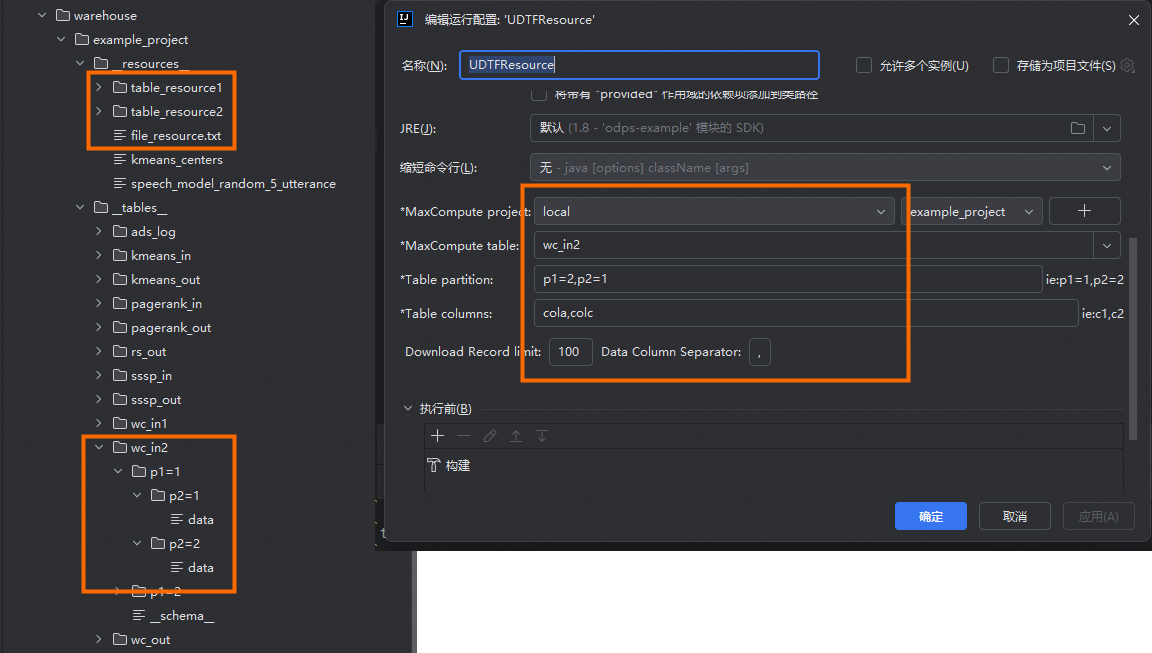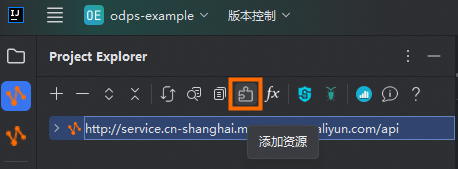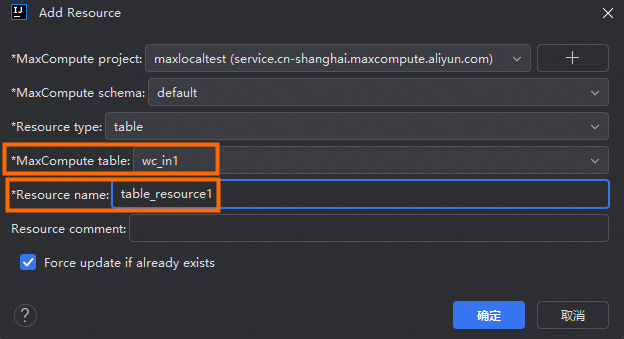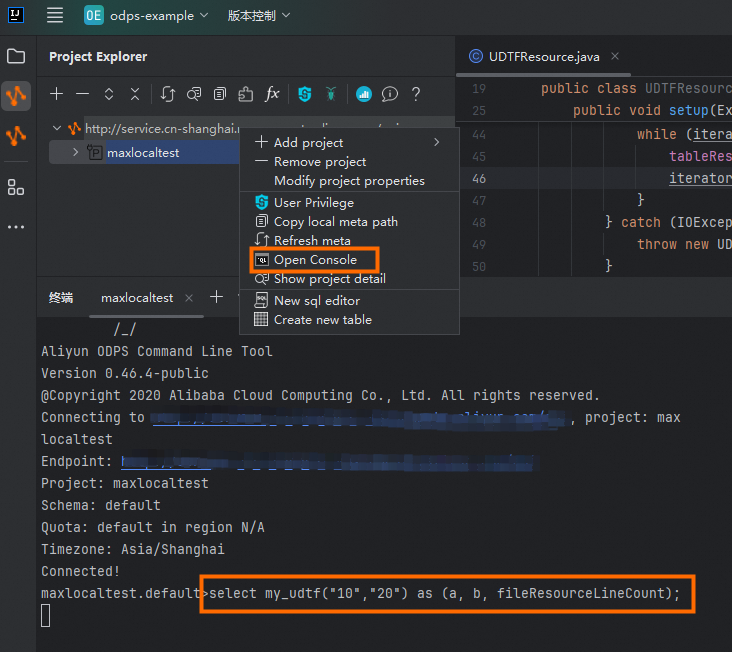本文為您介紹基於MaxCompute Studio通過Java UDTF讀取MaxCompute資源的使用樣本。
前提條件
已安裝MaxCompute Studio,並串連至MaxCompute專案,建立了MaxCompute Java Module。
已安裝開發工具IDEA 2024,JDK1.8版本。
更多操作資訊,請參見安裝MaxCompute Studio、管理專案串連和建立MaxCompute Java Module。
更多MaxCompute資源資訊,請參見資源。
UDTF程式碼範例
java UDTF代碼。
參數區別 | 參數類型 | 參數說明 |
入參 | 字串(string)。 | 第一個輸入參數。 |
字串(string)。 | 第二個輸入參數。 | |
出參 | 字串(string)。 | 第一個輸入參數值。 |
整型(bigint)。 | 第二個輸入參數字串長度值。 | |
字串(string)。 | file_resource.txt行數,table_resource1資源錶行數和table_resource2資源錶行數,三者拼接返回的值。 |
package com.aliyun.odps.examples.udf;
import java.io.BufferedReader;
import java.io.IOException;
import java.io.InputStream;
import java.io.InputStreamReader;
import java.util.Iterator;
import com.aliyun.odps.udf.ExecutionContext;
import com.aliyun.odps.udf.UDFException;
import com.aliyun.odps.udf.UDTF;
import com.aliyun.odps.udf.annotation.Resolve;
/**
* project: example_project
* table: wc_in2
* partitions: p1=2,p2=1
* columns: cola,colc
*/
@Resolve("string,string->string,bigint,string")
public class UDTFResource extends UDTF {
ExecutionContext ctx;
long fileResourceLineCount;
long tableResource1RecordCount;
long tableResource2RecordCount;
@Override
public void setup(ExecutionContext ctx) throws UDFException {
this.ctx = ctx;
try {
InputStream in = ctx.readResourceFileAsStream("file_resource.txt");
BufferedReader br = new BufferedReader(new InputStreamReader(in));
String line;
fileResourceLineCount = 0;
while ((line = br.readLine()) != null) {
fileResourceLineCount++;
}
br.close();
Iterator<Object[]> iterator = ctx.readResourceTable("table_resource1").iterator();
tableResource1RecordCount = 0;
while (iterator.hasNext()) {
tableResource1RecordCount++;
iterator.next();
}
iterator = ctx.readResourceTable("table_resource2").iterator();
tableResource2RecordCount = 0;
while (iterator.hasNext()) {
tableResource2RecordCount++;
iterator.next();
}
} catch (IOException e) {
throw new UDFException(e);
}
}
@Override
public void process(Object[] args) throws UDFException {
String a = (String) args[0];
long b = args[1] == null ? 0 : ((String) args[1]).length();
forward(a, b, "fileResourceLineCount=" + fileResourceLineCount + "|tableResource1RecordCount="
+ tableResource1RecordCount + "|tableResource2RecordCount=" + tableResource2RecordCount);
}
}pom.xml代碼,本地測試需要引入。
<dependency>
<groupId>com.aliyun.odps</groupId>
<artifactId>odps-udf-local</artifactId>
<version>0.48.0-public</version>
</dependency>操作步驟
本地測試
在MaxCompute Studio中建立UDTF類型的Java程式。例如Java Class名稱為
UDTFResource,程式碼為UDTF程式碼範例中的代碼。根據Java Module中warehouse資源內容,配置運行參數。
說明入參為本地資源中wc_in2表中分區p1=2,p2=1中每行第一列和第三列的值。
代碼執行擷取本地資源file_resource.txt中資料,table_resource1下對應表wc_in1中的資料,table_resource2下對應表wc_in2(p1=2,p2=1)的資料。

在類名UDTFResource上,按右鍵運行。並返回結果。


用戶端測試
單擊IDEA左上方
 Project Explorer,選擇
Project Explorer,選擇 添加資源。
添加資源。
根據MaxCompute執行個體資訊,添加file_resource.txt檔案。

分別添加table_resource1和table_resource2資源,類型為table。兩個資源地圖MaxCompute建立的表wc_in1和wc_in2。表中插入資料可以自訂。

將建立的UDTF打包為JAR包,上傳至MaxCompute專案並註冊函數。例如函數名稱為
my_udtf。在類名UDTFResource上,按右鍵Deploy to Server...,進入打包上傳介面。
單擊IDEA左上方
 Project Explorer,在目標MaxCompute專案上單擊右鍵Open Console,啟動MaxCompute用戶端,並執行SQL命令調用新建立的UDTF,並返回結果。
Project Explorer,在目標MaxCompute專案上單擊右鍵Open Console,啟動MaxCompute用戶端,並執行SQL命令調用新建立的UDTF,並返回結果。

範例程式碼如下。
SELECT my_udtf("10","20") AS (a, b, fileResourceLineCount);